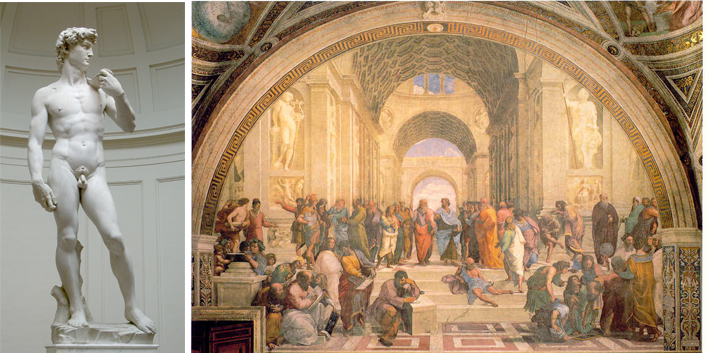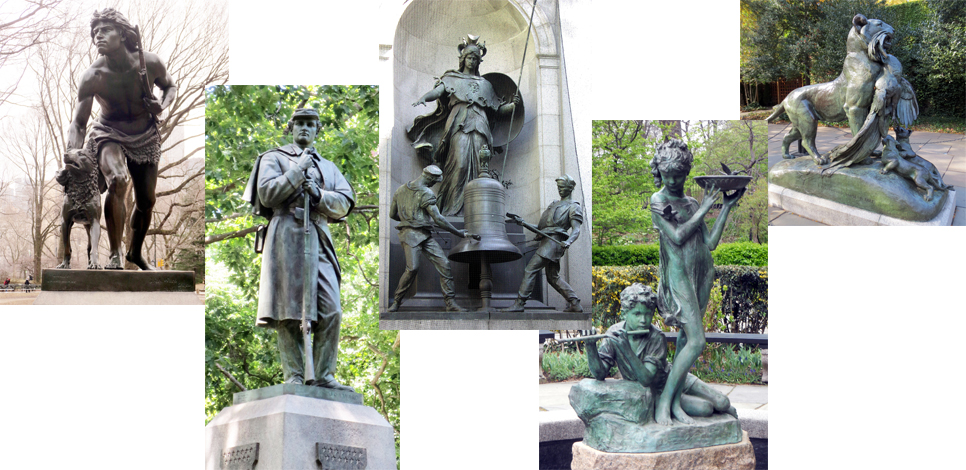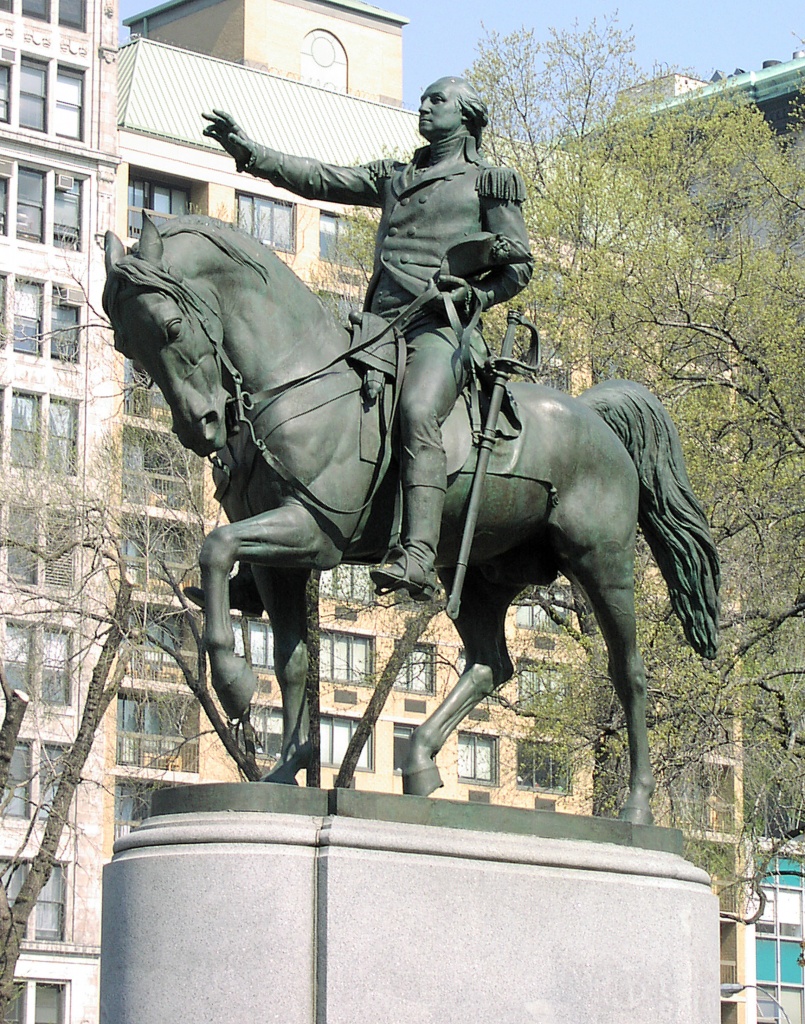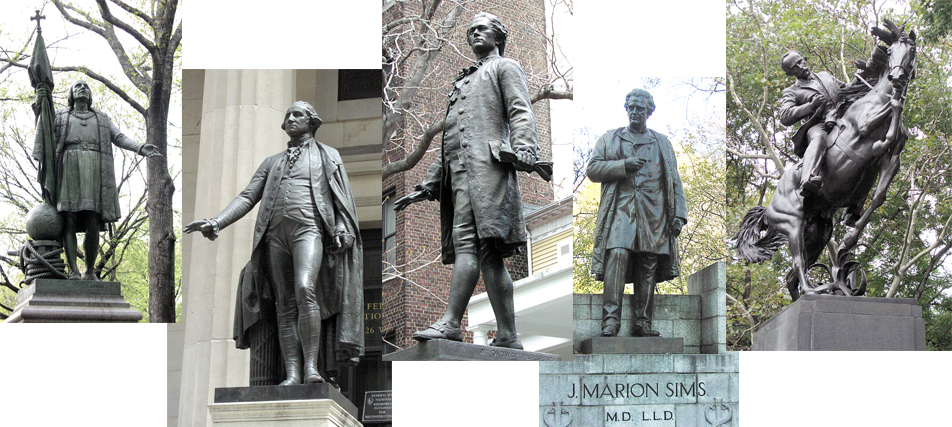Available as a printable PDF and as a video.
In the past few months, sculptures in Charlottesville, Baltimore, New York, and elsewhere have been lightning rods for love and for hate – rallying points for mobs and subjects of vandalism. Such events raise a wide range of questions: Why are these sculptures suddenly such a hot topic? Does the display of Confederate monuments empower neo-Nazis? If we destroy a sculpture, are we destroying history? Is there a First Amendment right to destroy statues, as well as to erect them? Will tearing down Confederate statues lead to tearing down sculptures of the Founding Fathers? Should we judge historical figures by the standards of their own time, or of ours?
I’ve spent about twenty years writing about and giving tours of outdoor sculpture in New York. That has often involved pondering the nature and function of art and its relationship to politics. I’d like to offer here some thoughts on three broad issues: public vs. private art; art vs. history; and portrait sculptures.
Art on Public vs. Private Property
When I drive up Norfolk Street toward East Houston in New York City, a statue of Vladimir Lenin looms over me. During his lifetime, Lenin was responsible for tens of thousands of deaths. I detest him as I detest all mass murderers. But he’s standing on the rooftop of a privately owned building, and the owner has a right to display anything from Lenin to pink flamingoes on his property. There are days when I can laugh at this sculpture: Lenin looks like he’s impotently trying to hail a taxi from a fourth-floor walk-up. On days when I’m thinking more of Lenin the man than of Lenin the sculpture, I reach Houston Street by a different route.

My reaction would be very different if Lenin were placed in Manhattan’s Union Square. Placing a sculpture on government-owned property implies that the government endorses and approves of what’s represented.
Most of the representational sculptures that now stand on government-owned property in New York were commissioned and paid for by private citizens during the nineteenth century. At that time, it was customary to donate sculptures to the city. (Our modern equivalent, erecting street signs that honor a particular person or group, is cheaper but much less expressive.) By 1876, when Central Park was barely twenty years old, its Board of Commissioners had assigned sites to seventeen sculptures.
Times change. Ideas change. What should we do today when a member of the public states that a sculpture on government-owned property is offensive?
Simple: sell the sculpture. In fact, all sculptures – whether they are currently on someone’s hit list or not – should be privately owned, and should stand on private property. A sculpture in private hands might be displayed on private property but visible to the public, as Lenin is. It might be placed in a museum, so that it would be available for study by fans or historians. It might disappear from view into someone’s personal art collection, as much art that comes up for auction does (temporarily, at least). It might be melted down or smashed to bits: owning a work gives you that option.
In any case, once the work was sold, the government could no longer be accused of endorsing or condoning whatever the sculpture celebrates.
That “whatever the sculpture celebrates” brings us to the question of art vs. history.
Art vs. History
History is real and objective: certain events happened in a certain way in the past, for certain reasons. We don’t always have the evidence to know the details, and sometimes our reconstruction of what happened changes with new evidence. The job of historians is to seek the truth about the past, to make sense of it, and to present it in such a way that it helps the rest of us learn how to deal with the present and plan for the future. History is recorded in words and illustrated in surviving artifacts.
An artist is not in the business of creating historical artifacts. Art’s purpose is not to teach or illustrate history. It’s to show us the artist’s view about life: what matters, what’s important, how the world can and ought to be. When an artist chooses to create a work of representational art, he is making a statement: “This is important, this matters, pay attention to this” – this value, this virtue, this idea, this action. Sometimes it’s this kind of place, this kind of feeling, this sort of person. By creating David, for example, Michelangelo said: “Courage and strength are important to me.” By creating the School of Athens, Raphael said: “It’s important to gain and pass on knowledge.”

What do you, as a viewer, get out of a work of visual art? What does it do for you that a Wikipedia article or op-ed can’t? Assuming that you agree with what the artist thinks is important, the work of art reminds you in a split second of what’s important to you. You see David, and you’re reminded of the value of courage and strength. You see the School of Athens, and you remember that gaining and passing on knowledge is important. The sight of the image brings a host of ideas, far more quickly than even the most brilliant writer could express them. The image doesn’t replace the ideas: it summarizes them, condenses them into a convenient package that you can call to mind in a split second. A print-out of the David and Goliath story can never have the impact of Michelangelo’s David.
That’s why representational art has been around for millennia. That’s also why its variety is as great as the variety of human beings. Your idea of what’s important may not be the same as mine, but sometime, somewhere, artists have probably shared your ideas and created works of art to encapsulate them.
Among the hundreds of outdoor representational sculptures in New York City are pieces that remind us of the importance of abstract concepts: for example, Justice, Liberty, Integrity, and Temperance.

Others offer messages via mythological figures, children, characters from literature, soldiers, and animals.

And then there are portrait sculptures: the type of art that has been getting all the attention lately.
Portrait Sculptures
Portrait sculptures show a real person – a hero – whose achievements someone considered worthy of honor and emulation. The earliest such sculpture standing outdoors in Manhattan is the equestrian sculpture of George Washington at Union Square, dedicated in 1856. It was the first large-scale sculpture erected after the equestrian sculpture of King George III was hauled off its pedestal in 1776.

Today more than a hundred portrait sculptures (some full-length, some busts) stand in Manhattan. Among them:
- Two of Christopher Columbus, honored for daring to set off across uncharted seas and for expanding the horizons of his contemporaries
- Five of George Washington, honored as the “Father of Our Country”
- Four of Alexander Hamilton, honored as a writer and orator, New York’s most famous Revolutionary War hero, and the man who ensured the financial survival of the United States
- J. Marion Sims, honored as the “Father of Gynecology”
- José Martí, honored as one of the leaders in the Cuban independence movement

But … no human being is omniscient and omnipotent. Every one of us has made errors, or taken actions that had unanticipated negative consequences. Columbus’s courage led to the European discovery of the Americas; but many indigenous Americans suffered as Europeans explored and settled the continents. Washington led the United States in war and in peace as no other man of his time could have; but he used slave labor to run Mount Vernon. Hamilton wrote many of the Federalist Papers and had a grasp of business and finances unmatched in his generation; but he had a torrid affair with Maria Reynolds. Sims’s medical studies and teaching saved thousands (even millions) of women from dying of undiagnosed “female complaints”; but his first three subjects were slaves, and he could not prove that he had their consent. Marti helped Cuba gain its independence from Spain; but that independence led to the dictatorships of Fulgencio Batista and Fidel Castro.
Modern intellectuals eagerly point out the flaws in the heroes of the past – the many ways in which they did not conform to current morals and mores. And yes, there’s a point in considering the ways in which these people fail to measure up to our standards. But to understand these historical figures in context, we should also ask: what if they had not achieved what they did? What if no European had discovered the Americas, and all of us still lived under the dictatorial powers of kings and emperors? What if the colonies had not broken free of British rule, and the Founding Fathers had not written and implemented the American Constitution – the first attempt anytime, anywhere, to set up a government designed to protect individual rights? How many women would have died if Sims had never wanted to diagnose and treat their illnesses? Would Cubans be better off if they had continued to live under the rule of the king of Spain?
Human beings are not perfect. That professor who taught you to think critically, that mentor who helped you navigate your first job, that friend who’s your model for how to deal with difficult situations – they all made mistakes somewhere along the line. So did those heroes to whom past generations erected portrait sculptures. To admire any of those people for their achievements doesn’t mean we need to blindly accept, admire, or imitate every single aspect of their lives. We just need to think about which aspects we do admire.
If every piece of representational sculpture owned by New York City were sold off and removed, I’d miss a hell of a lot. But I don’t need the government’s help to remind me who my heroes are. I might even enjoy the portrait sculptures of my heroes more if I didn’t have to dodge skateboarders, political demonstrators and traffic jams to visit them.
More
- This essay is available as a printable PDF and as a video: feel free to share! Guest posts on this subject: G.A. Mudge, Zenos Frudakis and Quent Cordair, Francis Morrone. You can also reach these by clicking Sculpture Controversy in the Obsessions cloud.
- The report of the Mayoral Advisory Commission on City Art, Monuments, and Markers is available at www1.nyc.gov/assets/
monuments/downloads/pdf/mac- monuments-report.pdf - The Lenin sculpture was brought to New York by one of the developers of the apartment building at 250 Houston Street, formerly known as “Red Square.” On 9/27/2016, the New York Times covered Lenin’s move to 178 Norfolk, with close-up photos. For more on the sculpture and the neighborhood, see Daytonian in Manhattan and Forgotten New York. The crazy clock atop the former Red Square is modeled after “Askew,” a 1984 watch by Tibor Kalman.
- Back in 2007 I published Outdoor Monuments of Manhattan: A Historical Guide, which describes 54 remarkable sculptures in Manhattan. Many of them are portraits, and for each of those, I briefly described some admirable aspect of their subjects’ lives. In Outdoor Monuments I also tackled a lot of esthetic questions that intrigued me. For example: why can two people react so differently to the same work of art? How do you discover and state the theme or message of an artwork: what the artist considered important? Is there an objective way to evaluate art? On the nature and function of art, see also my Innovators in Sculpture andGetting More Enjoyment from Sculpture You Love, which demonstrates a method for looking at sculptures in detail, in depth, and on your own.
- I have nothing to say about non-representational, abstract art – because it has nothing to say to me. See my essays on Christo’s Gates and the 2005 Turner Prize.
- If I could afford a bronze sculpture of a hero to stand on my own private property, it would be of Ayn Rand. The clarity of her thought, her ability to dig down to essentials, and her view of man as a heroic being have all changed my life profoundly and for the better. That whole section above on the nature and function of art is my restatement of parts of Rand’s Romantic Manifesto.
- In Getting More Enjoyment from Sculpture You Love, I demonstrate a method for looking at sculptures in detail, in depth, and on your own. Learn to enjoy your favorite sculptures more, and find new favorites. Available on Amazon in print and Kindle formats. More here.
- Want wonderful art delivered weekly to your inbox? Check out my free Sunday Recommendations list and rewards for recurring support: details here.
